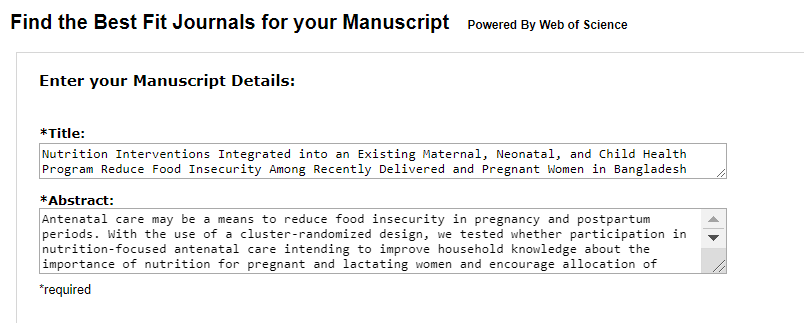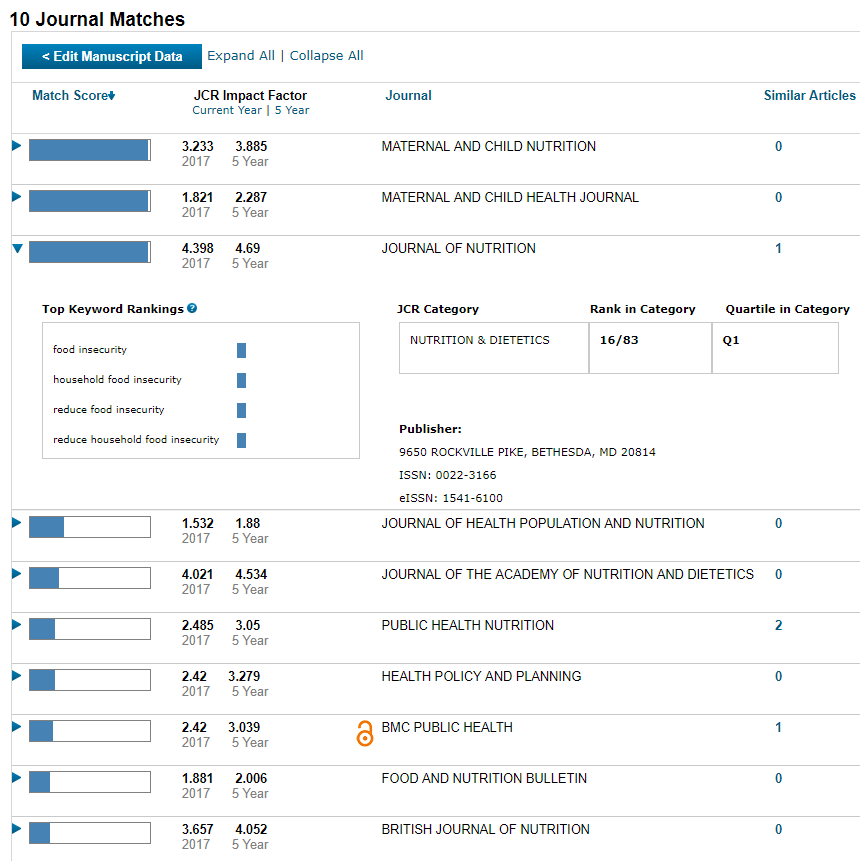As FHI 360’s Library Manager, I am often approached by colleagues asking me to recommend an appropriate journal for their manuscripts. A colleague recently asked for my opinion about a journal selection tool called EndNote Manuscript Matcher. The tool has been out for a few years but I (embarrassingly) had not had the chance to really delve into it. Could Manuscript Matcher be useful for me and my colleagues? I made a point to find out. Here I share what I learned and whether I recommend using it.
How to use Manuscript Matcher
After purchasing access to the Manuscript Matcher tool, you simply paste the title and abstract of your manuscript into the appropriate fields. You can also add your reference list to improve the accuracy of your results.
Ask the tool to “find journals” and it produces a list of 10 potential journal matches. The results include the latest Journal Citation Reports (JCR) impact factor for each journal (though that’s not relevant for everyone: Casadevall, et al., 2016).
This search process may feel backwards for some of you. Often researchers like to create their manuscript title and abstract last since it can be specific to the selected journal. If this is you, I suggest you start with a basic title and abstract to get things moving – and update them later.
One advantage of the tool is that it accesses citations from the Web of Science Core Collection, which indexes over 20,000 peer-reviewed journals covering over 250 science, social sciences, and humanities disciplines. Importantly for those of us working in the development sector, the database has expanded in recent years beyond publishers located in North America and Europe to include publishers from all parts of the world. The database includes journals published in over 45 languages. Though, English language journals still dominate the collection.
Testing the tool
I tested different manuscript titles and abstracts across several different disciplines. Not all 10 resulting journal matches for each topic were perfect, but every search returned solid journal options that I would want to explore further.
In the screenshots below, I used the (already published) journal article summarized in last week’s R&E Search for Evidence blog post to better illustrate how the tool works.
You can see below that I’ve taken the manuscript title and abstract and pasted them into the search fields.
You can see the results from my search below. The tool provides a match score (the bar in the left margin) for each of the journal matches. If you select one of the results, as I have done with the Journal of Nutrition (where the article is actually published), you can see the relevant JCR categories. Sometimes you can’t always tell what topic a journal covers from its title, so these categories can be particularly useful. Additionally, the top keyword rankings box shows which keywords – from the information I entered in the title and abstract search boxes – helped to match with this journal. For each journal match, there is a link to any similar articles already published in the journal.
Would I recommend using the tool?
Yes! I recommend using the Manuscript Matcher tool. It’s a quick and easy tool that will likely give you the right start for finding appropriate journals. In the sample search above, I was pleased to see that all the journal matches are journals that I have recommended many times for nutrition-related manuscripts.
There are some limitations that came to mind during my review.
First, there is the issue of cost. The tool is not free, though it comes with an EndNote license. Pricing appears to max out around $300 per license annually. Researchers with limited resources may find that cost a barrier. A hint of good news? Student discounts and institutional licenses are available.
Second, of course, Manuscript Matcher does not index every journal and there may be perfectly appropriate journals that do not show up as matches for your manuscript. For that reason, I think the tool is best used as a complement to the traditional ways of selecting a journal (i.e., searching for literature in relevant databases, seeking the advice of peers) which I outlined in a previous blog post.
Photo credit: Corey White/FHI 360





